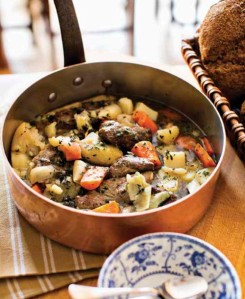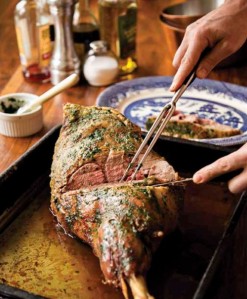Blog Archives
Skip the Corned Beef and Cook Up an Authentic St. Patrick’s Day Feast
Skip the Corned Beef and Cook Up an Authentic St. Patrick’s Day Feast
 Rachel Tepper
Rachel Tepper
YAHOO! Food
Mar 14, 2014
Prepare for your mind to be blown: No one in Ireland eats corned beef on St. Patrick’s Day. Or ever, really, according to Cathal Armstrong, the James Beard Award–nominated chef and owner of Restaurant Eve in Alexandria, Virginia. Armstrong should know—he grew up on the Emerald Isle.
“How many times can I say it? We never ate corned beef. It’s not really eaten in Ireland,” Armstrong told us, his brogue softened by more than two decades of living in the states. Rather, Irish families traditionally ate lamb, and that’s what they’ll likely be serving on March 17.
“I bet at least 80 percent of households are going to have leg of lamb,” Armstrong predicted. After all, it’s nearly springtime; lambs are ready for slaughter and peas and carrots are in season. “A leg of lamb feeds a good-sized Catholic family, which almost everyone in Ireland [has],” he said, although it might be a smaller “rack of lamb if they weren’t listening at the pulpit when they said, ‘Have as many kids as possible.’”
Armstrong estimated the remaining 20 percent might enjoy a whole Atlantic salmon, which has a long history in Ireland and is richly featured in the country’s folklore. One Celtic legend tells of a druid named Finegas, who for years waited by the banks of a river for the arrival of the “Salmon of Knowledge.” When he finally traps the fish, he hands it to his pupil Fionn to cook. But Fionn accidentally burns himself on the hot fish and sucks his thumb, thus gaining the salmon’s immense knowledge for himself.
If all else fails, there’s nothing wrong with a good Irish stew. But just make sure to use lamb rather than beef, and braise the stew for a few hours instead of simply bringing it to boil.
“[Boiled foods] aren’t really a fair representation of the food of the peasant people of Ireland,” Armstrong said. “They had braised hearty dishes that matched the climate.”
Below, enjoy three recipes from Armstrong’s new cookbook, “My Irish Table.” As Armstrong says, these “aren’t your typical diddle-idle-doo dishes.”
Irish Stew with Piccalilli
from “My Irish Table” by Cathal Armstrong and David Hagedorn
Serves 4
Kosher salt and freshly ground black pepper
4 (8-ounce) lamb shoulder chops
2 tablespoons canola oil
2 yellow onions, quartered lengthwise
2 carrots, peeled and cut crosswise into 2-inch pieces
3 cloves garlic, thinly sliced
1 large fresh bay leaf
2 russet potatoes, peeled and quartered
3 cups water
3 tablespoons chopped fresh thyme
Piccalilli
1. Brown the chops: Sprinkle salt and pepper liberally over both sides of the lamb chops. In a flameproof casserole over medium-high heat, heat
the oil until it shimmers. Brown both sides of the lamb chops well (2 to 3 minutes per side), working in 2 batches so the pot is not crowded. Transfer the browned lamb to a plate and set aside.
2. Cook the stew: Blot the oil from the pot with a wad of paper towels. Add the onions, carrots, garlic, and bay leaf. Top the vegetables with the chops and any collected juices on their plate. Add the potatoes and water. Bring the liquid to a boil. Lower the heat to medium, cover the pot, and let the chops simmer for 1 1/2 to 2 hours, until the meat is very tender. Adjust the salt and pepper seasoning to taste. Stir in the chopped thyme and serve immediately, with piccalilli on the side. The stew can be made the day before and gently reheated on the stove or in the oven at 300 degrees for 30 minutes.
Roast Leg of Lamb au Jus with Herb Pesto
from “My Irish Table” by Cathal Armstrong and David Hagedorn
Serves 8 to 10
1 (9-pound) bone-in leg of lamb (H-bone removed by your butcher)
2 tablespoons extra-virgin olive oil
2 teaspoons kosher salt
1 cup lamb demi-glace
herb pesto
1/2 cup extra-virgin olive oil
6 cloves garlic, crushed
1 cup fresh basil leaves
2 tablespoons chopped fresh thyme leaves
2 tablespoons chopped fresh rosemary leaves
1/2 teaspoon kosher salt
1. Roast the lamb: Preheat the oven to 350°F. Place the leg fat side up in a flameproof roasting pan. Rub it with the oil and season with the salt. Roast for 11/2 hours, until a meat thermometer inserted into thickest part of the lamb (but not touching the bone) registers 135°F for medium rare.
2. Make the pesto: Meanwhile, place the oil and garlic in the bowl of a food processor or blender and pulse briefly. Add the basil and process until a coarse purée forms. Add the thyme, rosemary, and salt and process briefly, until incorporated.
3. Add the pesto to the lamb: Transfer the lamb leg to a cutting board and spread 4 tablespoons of herb pesto over it. Cover the leg loosely with aluminum foil and let it rest for 15 minutes.
4. Make the jus: Meanwhile, skim and discard the fat from the roasting pan. Add the demi-glace to the pan and place over medium-high heat. Use a flat-edged wooden spatula to scrape up all the brown bits from the bottom of the pan.
5. Present the dish: Pour the jus into a small pitcher or gravy boat. Spoon the remaining pesto into a small serving bowl. Transfer the lamb to a serving platter and carve it at table. At about the middle of the leg, use a carving knife to cut a horizontal wedge the width of the leg and about 2 inches wide, cutting at a 45° angle from both sides until you hit bone. Then cut thin slices from both sides of the wedge. Once you’ve carved as much meat that way as you can, grasp the bone and stand it on its end with one hand, using your other hand to cut slices off the leg. Spoon some jus over each serving and place a little pesto on the side. Serve with your chosen side dishes.
Baked Whole Salmon with Hollandaise Sauce
from “My Irish Table” by Cathal Armstrong and David Hagedorn
Serves 12 to 14
3 tablespoons room temperature unsalted butter
1 (10- to 12-pound) eviscerated whole North Atlantic salmon, scaled
2 large bunches fresh thyme, separated into sprigs
1/2 lemon, thinly sliced, seeds removed
1. Prepare the foil wrapper: Preheat the oven to 375°F. Lay a sheet of 18-inch-wide aluminum foil slightly longer than your salmon on your work surface. Spread the butter evenly over it.
2. Prepare the salmon for baking: Towel dry the fish on both sides and lay it in the center of the buttered foil. Spread the thyme and lemon slices inside the cavity. Tightly wrap the foil around the fish, covering it completely. Lay it on a rimmed baking sheet (the sheet will probably be smaller than the fish).
3. Bake the salmon: Place the salmon, on the baking sheet, in the oven, curling up the tail to make it fit if necessary. (Put foil on the rack underneath the salmon to catch possible drips and keep your oven from becoming a mess.) Bake for 90 minutes, or until the tip of a knife poked through the foil and inserted into the center to the bone is warm.
4. Unwrap the salmon: Remove the salmon from the oven, place it on a large platter, and let it rest for 10 minutes. Use scissors to slice the foil open (watch out for steam) and then peel the foil away, rolling it up and tucking it under the sides of the fish. Peel away the skin between the gills and the tail, using a dinner knife (you don’t want a sharp edge). When you peel back the skin, you will reveal the bloodline. Scrape it away, along with any brown fat beneath it. There should now only be pink flesh visible.
5. Serve: Slice down the center of the fish to the bone horizontally and then cut portions however thick you want down the sides. They will lift easily off the bones. Once you cut away all the top portions, lift off and discard the fish’s spine. Cut portions from the bottom half, scraping away any skin and fat from them. Serve with hollandaise sauce.
Hollandaise Sauce
from “My Irish Table” by Cathal Armstrong and David Hagedorn
Makes 2 cups
6 large egg yolks
3 tablespoons water
1 1/2 cups warm clarified butter
Juice of 1 lemon, at room temperature
A few dashes of Tabasco sauce
Kosher salt
1. Beat the egg yolks: Using a large whisk, beat the yolks and water in a large stainless steel bowl until well combined. Then place the bowl directly over low heat and whisk vigorously until the yolks become frothy and very pale, resembling beat egg whites, about 5 to 7 minutes. Continue to cook and whisk until the yolks are completely cooked and thickened and the whisk makes visible furrows in the foam.
2. Add the butter: Remove the bowl from the heat and anchor it on a rolled towel on your work surface. With one hand, continue to whisk the yolks while with the other hand you slowly ladle the warm clarified butter into them. Add the butter in a continuous stream, incorporating it completely into the yolks with your whisk as you go along. After you add about half of the butter, add half of the lemon juice. Continue adding butter until the sauce is the texture of mayonnaise and tastes buttery, not eggy. (You may not need all of the butter. Freeze whatever remains for future use.) Add a few dashes of Tabasco, some salt, and the rest of the lemon juice if the sauce needs it. Strain the sauce through a fine-mesh sieve into a bowl that has been warmed with hot tap water and towel dried. Serve immediately.
All recipes reprinted with permission from My Irish Table by Cathal Armstrong, copyright © 2014. Published by Ten Speed Press, a division of Penguin Random House, Inc.



You must be logged in to post a comment.